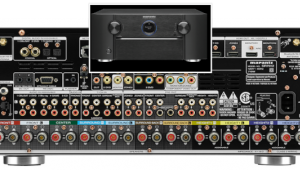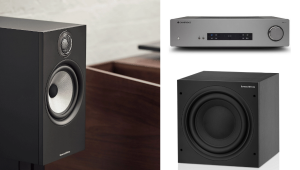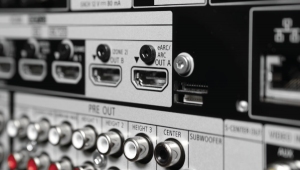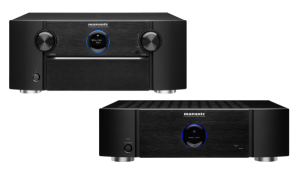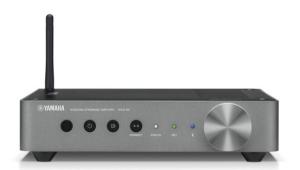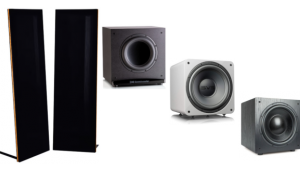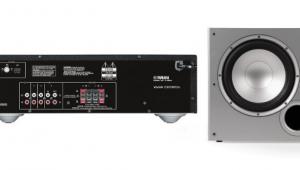Projection Screens, 3D AVRs, HDMI Cables

I am installing a new home theater, starting with a Panasonic PT-AE4000U projector, and I wonder about which screen to use. I would like a 16:9 or 2.35:1 screen. The room has some ambient light, but it can be made totally dark. What do you think of the Screen Innovations Black Diamond II? I have seen some YouTube videos about it, and it really looks great, but I wonder if it's worth the high price?
Gene Roney
If you can completely darken your room, you don't need the Black Diamond II, which is designed to be used in the presence of some ambient light. Screen Innovations claims that it works great with no ambient light as well, reducing light scatter compared with conventional screens, but even if that's true, I don't think you need to spend the extra money for such a screen unless you want the option of watching the projector with some ambient light in the room. In that case, the extra money is probably worth it. (BTW, the Black Diamond II 1.4 is a lot more than, say, the Solar HD 1.3 white material from Screen Innovations—$2200 vs. $1200 for an 80-inch screen.) We haven't evaluated the Black Diamond II, but Tom Norton has one in for review, which should happen in the next few months.
If you watch a lot of movies on Blu-ray, I would definitely get a 2.35:1 screen, especially with the PT-AE4000U, which has lens memories that automatically adjust the zoom and focus for 16:9 or 2.35:1 at a constant height. As for screen materials in a completely light-controlled room, I really like Stewart's Studiotek 100, but only if the room has black or dark gray walls, ceiling, and floor. Otherwise, I recommend Studiotek 130, though its price is about the same as a Black Diamond II. In any event, try to avoid light-colored walls, ceiling, and floor in any dedicated home theater.
3D AVR 411
I've heard that home-theater receivers need to be "3D-ready" with HDMI 1.4. If I don't have a 3D-ready receiver, will 3D still work? I don't want to upgrade my receiver to view 3D.
Mike Polk
The short answer is that, in most cases, you do need a 3D-ready receiver to pass 3D data through to the display. The long answer is more complicated; here's what HDMI Licensing has to say about it:
First, there are some hardware requirements that any A/V receiver must meet to be able to pass through the 3D data structures. Naturally, the HDMI receiver/transmitter needs to have enough bandwidth, and the AVR needs the right kind of decoder hardware.
There are legacy receivers that have this hardware. These receivers then need a firmware upgrade to be able to understand the new video structures. It is possible that some receivers might be able to pass the frame-compatible structures (broadcast formats) without requiring a firmware upgrade, because these formats pack the left and right images into a frame that is compatible with existing formats. But even in this case, the metadata would not be passed through, so the user would have to manually select the correct 3D mode to get a 3D picture. A firmware upgrade would fix this.
In the end, HDMI Licensing maintains that 3D is a completely new way of sending video information. To be entirely sure that the system is optimized for 3D requires an HDMI 1.4a A/V receiver. However, not everyone wants to upgrade their receiver just to pass through 3D data. These consumers have two options:
1. Contact the receiver's manufacturer and inquire if the firmware can be upgraded.
2. For 3D content, connect the source directly to the TV.
If you go with option 2, the only way to hear lossless audio is to connect the multichannel analog outputs from the player to the receiver's corresponding inputs, assuming that both devices have these connections available. Upgrading to a 3D-capable receiver would be far more convenient if you're into 3D.
Update: Reader Jesse reminded me of a third alternative to replacing your AVR. The Panasonic DMP-BDT300 and BDT350 3D Blu-ray players provide two HDMI outputs, which lets you connect one directly to the 3D display and the other one to a legacy AVR. That way, you don't need to connect the multichannel analog outputs from the player to the AVR, and you will still hear lossless multichannel audio via HDMI. I don't know of any other 3D Blu-ray players with two HDMI outs, but I hope other manufacturers follow Panasonic's lead on this.
Perennial HDMI Question
I have a PS3, Yamaha RX-V565 receiver, and Klipsch Quintet speakers. I have everything connected via Rocketfish 10.2Gbps HDMI cables. Would Monster or AudioQuest Forest, Chocolate, or Cinnamon HDMI cables make a difference? Also, if I were to use an optical digital-audio cable instead of running audio through HDMI, will it be affected? Which is better?
Gilbert Rodriguez
If your HDMI cable can support a bandwidth of 10.2Gbps, which is the maximum that HDMI can handle at this point, I don't believe that a more-expensive cable will make any appreciable difference in the video or audio qualityat least as long as the cable is a reasonable length, say under 15 feet or so. If the HDMI cable you're using now works without problems, you won't see or hear an improvement by switching to more-expensive cables.
However, switching to an optical digital-audio cable will definitely degrade the audio. The only way to get multichannel lossless audio from the PS3 is via HDMI; the optical output has enough bandwidth only for 2-channel uncompressed PCM or 5.1-channel Dolby Digital or DTS, both of which are lossy codecs. The first-generation PS3 can decode Dolby TrueHD and DTS-HD Master Audio and send multichannel PCM via HDMI, while the new PS3 Slim can also send the encoded bitstreams, which the RX-V565 can decode. Either way, HDMI is the only way to get the best possible audio performance from the PS3.
If you have a home-theater question, please send it to scott.wilkinson@sorc.com.
